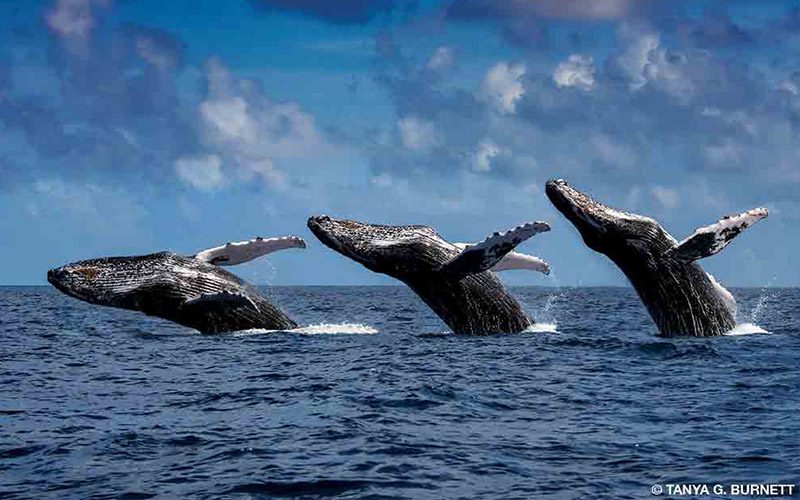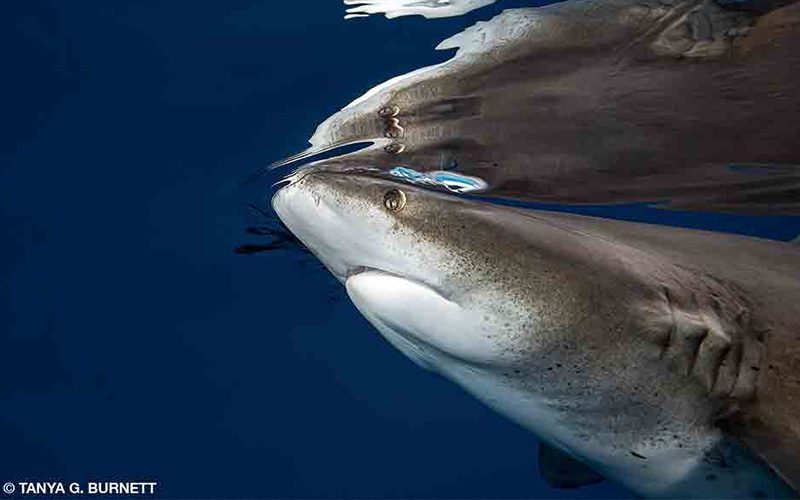Underwater photographers and dive operators live in symbiosis. We photographers couldn’t do our jobs without the boats and services of dive professionals, and we hope the articles we write and the photos we publish will inspire others to enjoy the locales the operators service. Despite this interdependence, however, it’s uncommon for an individual to have made an impact as both a dive professional and an underwater photographer. Such is the unlikely path forged by Tanya Burnett.
Burnett was born in Wisconsin, but soon afterward her father moved the family to the U.S. Virgin Islands, where he managed a distribution center for Hobart, a provider of equipment and services to the food retail industry. This provided Burnett with an early childhood of playing in the crystalline waters of St. Thomas.
St. Thomas is where she first saw the world beneath the surface through a face mask, but she began diving and snorkeling in earnest when the family relocated to Miami, Fla. There she explored the waters of Biscayne Bay from her 13-foot Boston Whaler. A graduate of North Miami High, Burnett matriculated to Barry University in Miami Shores and entered its Sport Management–Diving Industry program, an innovative, accredited curriculum developed by dive industry icon Tom Ingram (now president and CEO of the Diving Equipment and Marketing Association [DEMA]). Only the third woman to graduate from this program, Burnett not only became a scuba instructor but also left school determined to seek a suitable business opportunity. With her education, a $100,000 loan from her dad and a U.S. Coast Guard captain’s license, the 21-year-old Burnett was on the hunt for the right dive business to acquire.

All who make the sojourn to the Silver Bank, Dominican Republic, between February and April go to be in the water with Atlantic humpback whales. But even while at anchor on the liveaboard, the action can begin at any moment. We noticed a lot of surface action not far from the boat and ventured out to observe three male humpbacks in an apparent competition, displaying all manner of grunting and roaring vocalizations, rostrum blows, lateral fluke swipes, bubble streams and head lunges in the course of mating challenges. Here a male humpback whale breaches after dueling a few other males for a female. This image is a composite of three frames from a motor-drive sequence of a single whale and a single breach.
After exhausting the area’s supply of dark and dingy dive shops that might be for sale, in 1991 she created the shop of her dreams — bright, airy and primed for underwater adventure: H2O Scuba in North Miami. Located on the water and with an early technical-diving bias (hers was the first shop to pump what was then known as “voodoo gas” — nitrox), Burnett’s shop began working with Tom Mount and Bret Gilliam, respected pioneers in technical-diving education. That collaboration led to Burnett’s involvement in Technical Diving International (TDI) as a principal and a contributor to the texts for the Nitrox, Advanced Nitrox, and Trimix curricula.
The shop grew very quickly in the early 1990s, but Burnett was keenly aware that brick-and-mortar scuba shops were under competitive pressure from online vendors. In a prescient and fortuitous moment she found a buyer for her shop, paid back her dad and established a version 2.0 career as a sales representative for TDI instructional programs, UWATEC computers and Dräger semiclosed-circuit rebreathers. Her territory included South Florida and the Florida Keys, and her dive and photo opportunities continued to expand. Around this time she also began leading expeditions to places such as Cocos Island, which commonly involved such logistical undertakings as shepherding 30 rebreathers through customs and onto liveaboards.

Cat Island is a rarely visited island ringed with blinding white sand and achingly beautiful water. It is also a special location that redefines our often dubious opinion of the oceanic whitetip shark (Carcharhinus longimanus). When I slipped into the deep velvety blue off the southern end of the island to meet a half dozen circling oceanics for the first time, I brought my respect, if not my fear. Belying their reputation as man-eaters, these predators were calm, methodical and unbelievably beautiful as the bright Bahamian sun danced across their backs.
Underwater cameras were an important part of her world then, useful for illustrating textbooks and as a creative outlet during her time in the water. But Burnett’s career as a photojournalist likely had its genesis in a 1995 assignment from Fred Garth of Scuba Times: traveling to Borneo and Sipadan with the Borneo tourism authority as the client — a very nice first gig. This led her down a path familiar to many underwater journalists: illustrating travel articles, writing for dive magazines and selling stock photos through the agencies of the day. By 2002 she was leading dive trips around the world and finding success in selling fine-art photography to collectors. In 2006 she married her underwater photo colleague, Kevin Palmer, and the couple founded Island Exposure Inc.
Despite Burnett’s professional success as both an artist and entrepreneur, she has dealt with her share of unpleasantness as a woman in a male-dominated industry. Photographer Allison Vitsky Sallmon once asked Burnett in an interview, “Has anyone ever said or done anything blatantly sexist or offensive to you as a diver?” Burnett replied:
Oh yes! When I owned and operated my dive store starting at the age of 22, most guys didn’t want to ask me anything about dive gear, diving or spear guns. They would all look at my partner and defer to him for everything. He would purposely defer back to me, and I would end up taking over the conversation and giving the guy the information he was looking for. Surprise! We always giggled about how a 22-year-old woman could possibly know so much about this “man’s world” of diving. I still occasionally get an amused look when I’m gearing up for a dive with my camera system in hand, followed by the words, “Boy, that camera is bigger than you are; can you handle it?”
Clearly she can handle the camera, as the images that follow so artfully attest.

Indonesia is a wonderland of underwater imaging possibilities, and its regions are extraordinarily diverse and far-flung. In South Pantar I was amazed after descending a steep wall into a forest of rare red soft coral (Dendronephthya sp.). These corals were giants of their species, towering 4-5 feet over the sand bottom. After trying to capture the whole forest somewhat unsuccessfully, I realized it might be better to focus on a single “tree” and try to capture its grandeur. Nowhere else in the Indo-Pacific have I seen such soft corals

The opening of Cuba to American tourism has certainly been a boon to fans of Caribbean diving. And Cuba offers some amazing treasures beneath the surface that you won’t find elsewhere in the Caribbean. One of the most exciting opportunities for me was the chance to photograph saltwater crocodiles (Crocodylus porosus) in the wild. I have had some modest and limited encounters in the Western Pacific, but I was completely taken aback by these relaxed and approachable reptiles in the shallow crystalline waters of southern Cuba. My nerves were quickly calmed by their behavior, and curiosity soon took over. This is perhaps the best opportunity anywhere in the tropical Atlantic for this rare interaction, and it’s well worth the short trip to Cuba.

Black-sand muck sites often look like wastelands at first. Such was the case at PJ’s in Bali. I began conducting a search pattern over the bottom, wondering where all the critters were. The only thing that broke the monotony of the bottom was a coconut shell. With nothing else to distract me, I poked it with muck stick to see if anything was underneath. Nothing. But as I rolled it, I suddenly realized that one of the “eyes” of the coconut was looking back at me. I backed off and waited. Finally, a suction-cupped arm slithered out of a crack in the coconut, followed by a gelatinous procession of additional octopus parts squeezing through the small opening. Eventually all eight legs unfurled and raised this mobile home off the seafloor on tentacle toes that danced lightly across the sand in hasty retreat. I had found the legendary coconut octopus (Amphioctopus marginatus) in its namesake home.

Mantis shrimp hold so many records that it is clear they punch well above their weight class. Most complex eyes in the animal kingdom? Check. Fastest limb movement achieved by any animal? Check. Hardest punch per surface area of any animal? Check. And they do all this amid the significant resistance of seawater. I think the peacock mantis shrimp (Odontodactylus scyllarus) — there are many species of mantis shrimp — is also one of the most elegant and entertaining creatures in the sea. Sometimes shy, sometimes bold, these masters of mischievous trickery reside in holes in the reef but always have a backup escape hole as well. Any time I spot one on a dive, I pause to see what it is up to. I saw this one displaying its signature emerald and blue back toward me. As it turned, it revealed a brilliant pink clutch of eggs, displayed proudly like a feather boa.

Indo-Pacific manta rays (Mobula birostris) are graceful, silent, mysterious and, regrettably, threatened — listed as vulnerable by the International Union for Conservation of Nature and Natural Resources (IUCN). The rays are under severe fishing pressures in some areas, and because of increasing interest by both the traveling public and the international scientific community, more and more manta congregation areas are being discovered around the world. Thanks to research and conservation efforts such as the Misool Manta Project, Indonesia instituted a nationwide ban on manta fishing and commerce in 2014. It was with great excitement that I dived in the remarkable Misool Marine Reserve in Raja Ampat during a period when officials counted the highest number of visiting mantas they had ever witnessed. One site in particular, Magic Mountain, featured a large cleaning station that dozens of mantas visited every day.
| © Alert Diver — Q4 2017 |